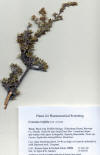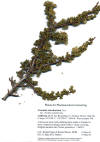|
Evergreen shrubs; leaves aromatic, alternate, wedge-shaped, entire, dentate or apically divided, resinous, glandular dotted, margins revolute; flowers solitary, showy, petals usually 5, stamens numerous; gynoecium apocarpous, 1–12 carpels developing within a cupular, bowl-shaped or funnelform hypanthium, the style of each carpel elongating in fruit, feather-like to bristly, pericarpium indehiscent (camara). Possibly 7 species, often on limestone, high deserts, Chihuahuan, Arizona, Mohave, Great Basin, from central Mexico north to Colorado west to California. Cowania is lumped with Purshia in the Jepson Manuals, JM1 (Thomas Rosatti,1993), JM2 (Brian Vanden Heuvel & Rosatti 2012) and in the Intermountain Flora (N. Holmgren in Cronquist, N. H. Holmgren & P. K. Holmgren, 1997). The arguments for this seem to be based on hybridization and introgression between Cowania stansburyana and Purshia glandulosa and P. tridentata (Stutz & Thomas 1964). Some of the species and varieties not recognized in current taxonomic literature, C. alba, C. davidsonii, C. subintegra, and C. mexicana var. dubia, are viewed as local hybrid variants. Cowania subintegra also has been treated as hybrid of ancestral species, Purshia pinkavae. Previous floristic accounts (Abrams, Jepson, Munz) distinguished Cowania from Purshia by the number of carpels; however, P. tridentata in the Rocky Mountains frequently has 1–3 carpels, often on the same plant. The distinction made here is based on the fruiting style; in Cowania the style elongates and becomes feathery or bristly as opposed to appearing persistent in Purshia. The key below to species of Cowania was extracted in part from Rydberg, North American Flora Vol. 22 (1913).
Cowania alba Goodding 1904. Shrub, 1.5-2.5 m. high, with white bark; leaves expanded apically, 3–5 lobed, tapering into broad petioles, 8-10 mm. long, dark-green and glandular-dotted above, barely tomentose beneath, strongly revolute on the margins; flowers terminal, solitary; hypanthium narrowly funnel-form, glandular-dotted and silvery-tomentose; sepals oblong, obtuse, 3 mm. long; petals white, obovate, irregular, distinctly clawed; carpels 2 or rarely 3; fruiting style short, scarcely plumose, hirsute. (Perhaps a hybrid of C. stansburyana and Purshia tridentata) Type from Bunkerville, Nevada. Includes C. mexicana var. dubia Brandegee 1903, type from Providence Mts. Cowania davidsonii Rydberg 1913. Shrub; twigs chestnut brown, glandular and slightly tomentose, ashy-gray on branches; leaves 1 cm. long, mostly 3-cleft, divisions usually toothed, minutely glandular-punctate above, white-tomentose beneath, slightly revolute-margined; flowers terminal, solitary; pedicels 5–8 mm. long, with stalked glands; hypanthium funnelform-obconic, 4–5 mm. long, glandular; sepals rounded-ovate, rounded or acutish at the apex, 4 mm. long, more or less tomentose; petals broadly obovate, 8 mm. long, yellowish; stamens many; filaments filiform; carpels 5–8; styles in fruit about 4 cm. long, glabrous tips scarcely more than 1 mm. long. Type from Blue River, Arizona, Cowania ericifolia Torrey ex A. Gray 1853. Heath Cliffrose. Low, intricately branched shrub to 1 m; bark dark brown, fissured, leaves linear-subulate, spinulose tipped, entire, leathery, resinous, glandular dotted, 4–6 mm, margins revolute; flowers July-Oct, 1–3 at end of branchlets, white to yellowish, petals 6–8 mm; stamens numerous; gynoecium apocarpous, carpels 8, developing long feathery styles 15–25 mm long; hypanthium cupular to funnelform, 3 mm long , persistent, with gland tipped hairs. Limestone rocks, southwestern Texas to Coahuila, Mexico. Cowania mexicana An erect branched shrub, 1–2 m. high, with short branches and brown bark, tomentose when young; leaves 3-cleft, with oblong, entire lobes, 5–10 mm. long, glandular-punctate above, without stalked glands, white-tomentose beneath, margins revolute; stipules adnate to the short petioles, the free portion lanceolate; flowers solitary, terminal; pedicels 2–5 mm. long, tomentose, the glands sessile and often hidden in the tomentum; hypanthium campanulate, 3–4 mm. long, rather abruptly contracted into the pedicel; sepals imbricate, rounded, ovate, or obovate, rounded to apex, 3 mm. long, tomentose when young, with sessile glands; petals yellow, broadly obovate, about 8 mm. long; stamens many; filaments filiform; carpels 5–10, densely villous; lance-oblong, 3–4 mm. long; styles ~4 cm. long; glabrous tips 1-2 mm. long. Central Mexico. Cowania plicata D. Don 1838. Shrub 1/2 –2 m, twigs white tomentose, glandular; bark brownish shredding; leaves clustered on short spur shoots, wedge-shaped, widest just below apex, 0.6–2.0 cm, green above, whitish cottony hairy below except for veins, shallowly lobed from apex to near mid region, margins revolute; flowers 1–3 at end of leafy short to long leafless spur shoots, on densely glandular pedicels 2–5 mm long, rose to purple, petals 10–12 mm; sepals imbricate, adnate to the short petioles, ovate, 5–6 mm, tomentose and glandular; stamens numerous; gynoecium apocarpous, carpels 6–10, developing long feathery styles 4 mm long with hairless tips ~1 mm, pericarpia silky, 6–7 mm; hypanthium bowl-shaped, 4–5 mm, glandular; Rocky hillsides, Mexico: Coahuila, San Luis Potosi, Zacatecas, and Guanajunto. Type from cultivated plants in upland Mexico, grown from seed. Cowania stansburyana Torrey 1852. Shrub 1–3.5(-7.5 ) m; twigs reddish brown, glandular; bark gray, shiny, exfoliating; leaves clustered on short spur shoots, wedge-shaped, jointed above stipular base, widest just below apex, 0.6–1.5 cm, (3-) 5–7 lobed, green above, glandular punctate, whitish cottony hairy below except for prominent veins, margins revolute, undulate; flowers solitary at end of short leafy shoots, on densely glandular on pedicels 2–8 mm, gradually expanding into hypanthium; flowers white to cream, petals 7–14 mm; sepals ovate, 4 mm, rounded to pointed; stamens numerous; gynoecium apocarpous, carpels 4–10, developing long feathery styles to 4.5 mm long with hairless tips ~1 mm, pericarpia silky, 6–7 mm; hypanthium narrowly obconic to bowl-shaped, 4–6 mm, glandular. Rocky hillsides, often along washes in canyons, Colorado to California and northern Mexico. Type from Stansbury Island, Great Salt Lake, Utah. Cowania subintegra Kearney 1943. Includes Purshia pinkavae Schaack1987. Low shrub, generally wider than tall, to 3.7 m wide and 2.4 m high, twigs reddish brown, the bark becoming gray and shredded with age; leaves densely clustered on short spur shoots, with a red dot below the leaf fascicle, narrowly wedge-shaped, widest just below apex, 8 mm long, dark green, , obscurely or not glandular above, loosely white arachnoid hairy, whitish cottony hairy below, entire to shallowly lobed on one side just below apex, not resinous, margins revolute; flowers at end of leafy spur shoots, white to pale yellow, petals 5(-12), 10 mm; stamens numerous; gynoecium apocarpous, carpels 3–7, developing short feathery styles; hypanthium funnelform, without gland-tipped hairs, 5.1 mm. Arizona Desert at scattered locations, apparently a species that intergrades with C. stansburyana, or possibly a hybrid between C. stansburyana and Purshia glandulosa Type from southwestern Mohave Co near Burro Creek.
| Ito H., M. Miyake, E. Nishitani, K. Mori, T. Hatano, T. Okuda, T. Konoshima, M. Takasaki, M. Kozuka, T. Mukainaka, H. Tokuda, H. Nishino and T. Yoshida. 1999. Anti-tumor promoting activity of polyphenols from Cowania mexicana and Coleogyne ramosissima. Cancer Lett. 143(1): 5–13. “Chemical investigation on polyphenol-rich fractions of Cowania mexicana and Coleogyne ramosissima (Rosaceae) which showed significant inhibitory effects on Epstein-Barr virus early antigen (EBV-EA) activation induced by 12-O-tetradecanoylphorbol-13-acetate (TPA), has led to the characterization of 10 compounds including C-glucosidic ellagitannin monomers and dimers from the former plant, and 17 polyphenols including flavonoid glycosides from the latter. The effects of individual components and their analogues with related structures on the TPA-induced EBV-EA activation were then evaluated. Among the compounds isolated from C. mexicana, two C-glucosidic ellagitannins, alienanin B and stenophyllanin A and a nitrile glucoside (lithospermoside), and among the constituents from C. ramosissima, two flavonoid glycosides, isorhamnetin 3-0-beta-D-glucoside and narcissin were revealed to possess strong inhibitory effects on EVB-EA activation, the potencies of which were either comparable to or stronger than that of a green tea polyphenol, (-)-epigallocatechin gallate. These polyphenols except for nitrile glucoside, which was not tested owing to an insufficient amount, were also found to exhibit anti-tumor promoting activity in two-stage mouse skin carcinogenesis using 7,12-dimethylbenz[a]anthracene (DMBA) and TPA.” Konoshima T, M. Takasaki, M. Kozuka, M. Haruna, K. Ito, J. R. Estes and K. H. Lee. 1993. Constituents of rosaceous plants. I. Structure of new triterpenoids from Cowania mexicana. Chem. Pharm. Bull. (Tokyo) 41(9): 1612–615. In our search for possible anti-tumor-promoters, we carried out an investigation of the leaves and branches of Cowania mexicana D. DON (Rosaceae). Two new cucurbitane type triterpenes, 15-oxo-cucurbitacin F (3) and 15-oxo-23,24-dihydrocucurbitacin F (4), were isolated together with cucurbitacin F (1) and 23,24-dihydrocucurbitacin F (2). These triterpenes were inhibitors of Epstein-Barr virus early antigen activation induced by 12-O-tetradecanoylphorbol-13-acetate, a well-known tumor-promoter. The structures of 3 and 4 were determined from 2D-NMR spectral data and difference NOE experiments. Stutz, H.C., and Thomas, L.K. (1964). Hybridization and introgression in Cowania and Purshia. Evolution 18, 183–195.
|














